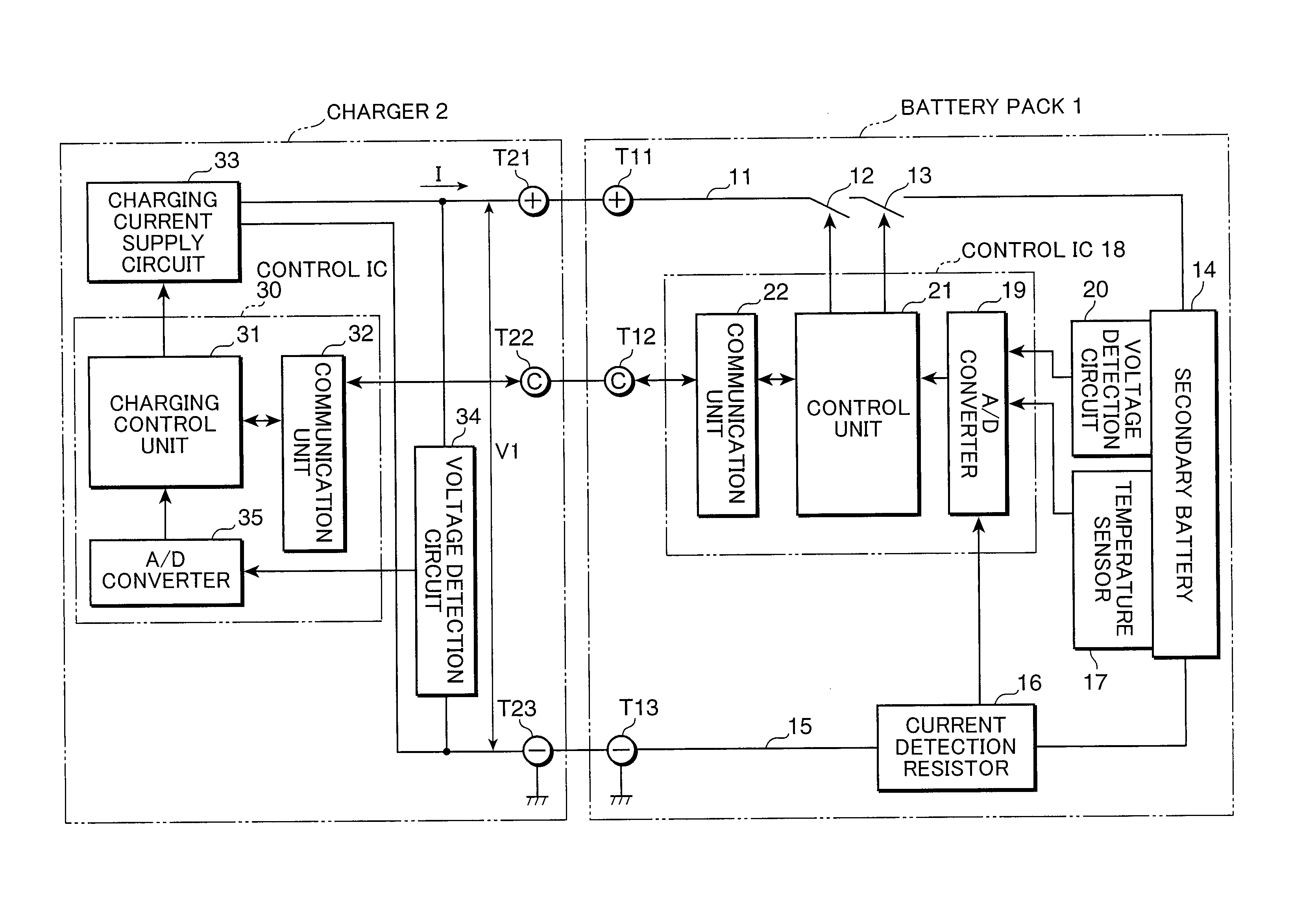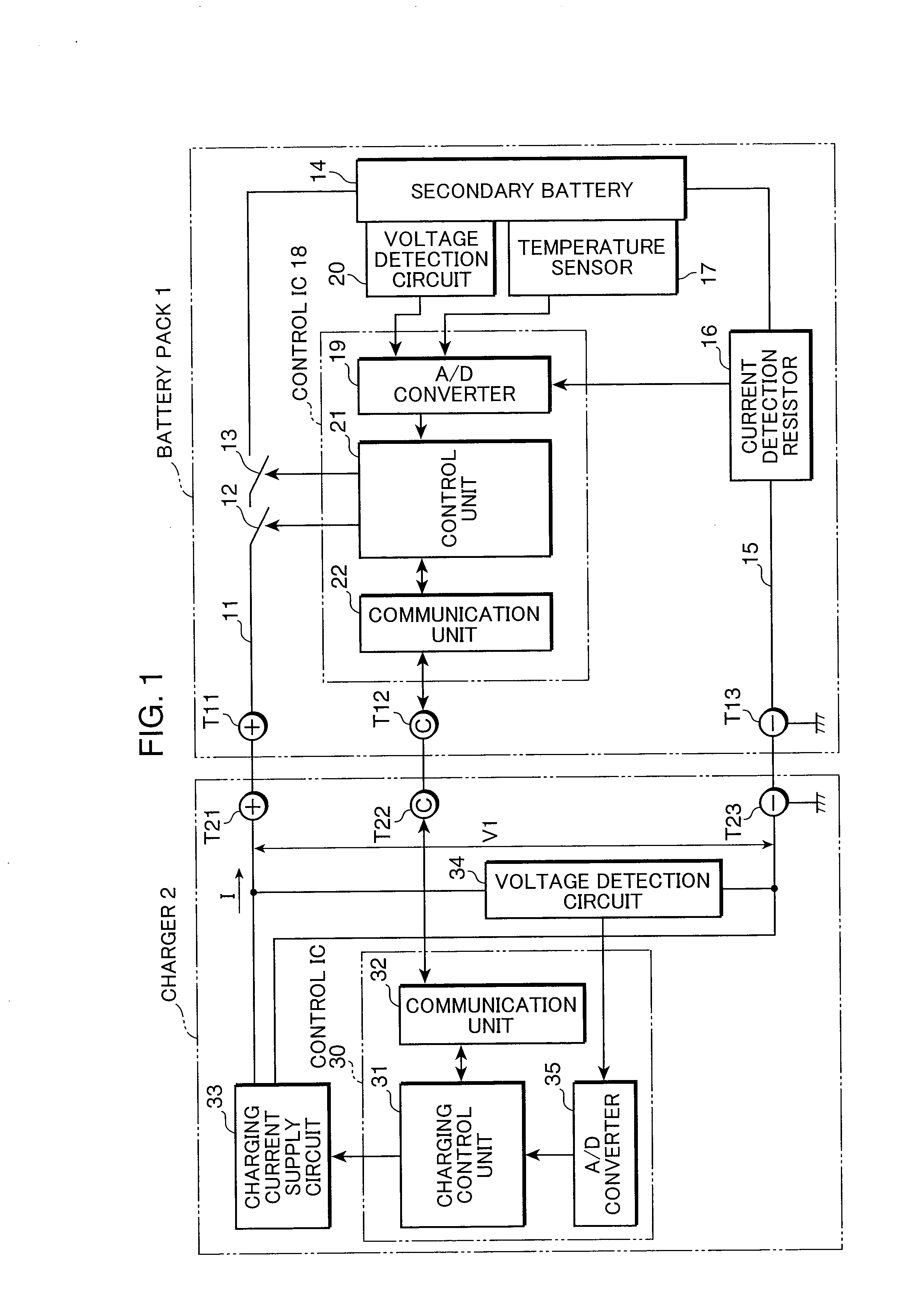Method of quick charging lithium-based secondary battery and electronic device using same
a lithium-based secondary battery and electronic device technology, applied in secondary cell servicing/maintenance, instruments, cell components, etc., can solve the problems of insufficient charging time and actual battery cannot be charged up to a full charge, and achieve the effect of quick charging and preventing overcharging
- Summary
- Abstract
- Description
- Claims
- Application Information
AI Technical Summary
Benefits of technology
Problems solved by technology
Method used
Image
Examples
embodiment 1
[0024]FIG. 1 is a block diagram illustrating the electric configuration of the electronic device of Embodiment 1 of the present invention. This electronic device is constituted by providing a charger 2 that charges a battery pack 1 and a load device (not shown in the figure) in the battery pack. In the configuration shown in FIG. 1, the battery pack 1 is charged from the charger 2, but it is also possible to mount the battery pack 1 on the load device and charge the battery pack via the load device. The battery pack 1 and charger 2 are connected to each other by terminals T11, T21 on the DC-high side that conduct power supply, terminals T12, T22 for communication signals, and GND terminals T13, T23 for power supply and communication signals. Same terminals are provided even when the load device is not provided.
[0025]FET 12, 13 that have mutually different conductivity modes for charging and discharging are introduced in a charge-discharge path 11 on a DC-high side that extends from ...
embodiment 2
[0042]FIG. 5 is a flowchart illustrating in detail the charging operation in the electronic device according to Embodiment 2 of the present invention. In this embodiment, the above-described configuration of electronic device shown in FIG. 1 can be used. The processing illustrated by FIG. 5 is similar to the above-described processing illustrated by FIG. 3, and the corresponding portions are assigned with identical step numbers and explanation thereof is herein omitted. A noteworthy feature of the present embodiment, it that that the charge end voltage Vf′ is determined not only by the internal resistance value R, but also by taking into account the terminal voltage V1 and actual capacity W of the secondary battery 14. As shown in FIG. 2, the internal resistance value R (DC-IR) not only decreases with the increase in temperature, but also changes depending on SOC (State of Charge), as shown in FIG. 6. Further, the internal resistance value R increases as the deterioration advances d...
embodiment 3
[0050]FIG. 8 is a block diagram illustrating a configuration example of the electronic device of Embodiment 3 of the present invention. In FIG. 8, components identical to those of the electronic device shown in FIG. 1 are assigned with identical reference numerals and explanation thereof is omitted. The electronic device shown in FIG. 8 differs from the electronic device shown in FIG. 1 in the aspects as follows. Thus, in the electronic device shown in FIG. 8, a control unit 21a functions as a charging control unit 210, an internal resistance estimation unit 211, and a charge end voltage calculation unit 212.
[0051]The charging control unit 31a dose not performs the detection of the internal resistance value R, setting of the charge end voltage, and determination of charge end. Further, a load device 4 is connected between a terminal T21 and a terminal T23. The discharge current of the secondary battery 4 and the current outputted from the charging current supply circuit 33 is suppli...
PUM
| Property | Measurement | Unit |
|---|---|---|
| voltage | aaaaa | aaaaa |
| negative electrode potential | aaaaa | aaaaa |
| charge voltage | aaaaa | aaaaa |
Abstract
Description
Claims
Application Information
 Login to View More
Login to View More - R&D
- Intellectual Property
- Life Sciences
- Materials
- Tech Scout
- Unparalleled Data Quality
- Higher Quality Content
- 60% Fewer Hallucinations
Browse by: Latest US Patents, China's latest patents, Technical Efficacy Thesaurus, Application Domain, Technology Topic, Popular Technical Reports.
© 2025 PatSnap. All rights reserved.Legal|Privacy policy|Modern Slavery Act Transparency Statement|Sitemap|About US| Contact US: help@patsnap.com



